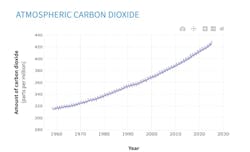Microsoft and Carbon Direct: High-Quality CO2 Removal Faces Critical Challenges
Carbon capture and storage momentum has taken a hit by the Trump Administration lately and yet the work to decarbonize by post-emission carbon removal is bolstered by several high-profile commercial and industrial players.
In the latest advance, tech giant Microsoft has totaled close to 22 million metric tons in procurement to join with other companies in creating a market for carbon dioxide removal. This week, Microsoft and C02 management firm Carbon Direct teamed up to release the fifth edition report on “Criteria for High-Quality Carbon Dioxide Removal (CDR),” which touts carbon credit procurement, designs for new projects doing so and, for the first time, offers guidance on ocean-based carbon removal pathway including ocean alkalinity enhancement and direct ocean removal.
A consensus of many environmental scientists contends that CO2 and other greenhouse gases are causing a global climate crisis due to the heating up of the earth’s atmosphere. Last year, a new record of atmospheric C02 was set at about 422.7 parts per million, according to the U.S. National Oceanic and Atmospheric Administration (NOAA).
The Carbon Direct-Microsoft report on Criteria for CDR predicts that global communities must remove 100 billion to 1 trillion metric tons of CO2 by the year 2100 to limit “persistent warming” of the atmosphere to more than 1.5 degrees Celsius (or nearly 3 degrees Fahrenheit) above historic levels since the start of the industrial age. Higher temperatures in the air and oceans can feed more extreme storms in hurricanes, tornadoes and rainfall flooding, climate change advocates say.
“Over the past five years, Microsoft and Carbon Direct have observed a critical challenge in the emerging CDR industry,” reads the introduction to the Criteria report. “Recent policy announcements also highlighted the pressing need for evidence-based CDR criteria to guide action by both public and private-sector actors. In the United States, the Inflation Reduction Act and the Infrastructure Investment and Jobs Act continue to provide funding for CDR project development.”
However, the Trump Administration has taken cuts at the initial IRA and IIJA incentives for carbon removal. Last month, the U.S. Department of Energy terminated $3.7 billion in previously announced decarbonization project awards, including nearly $1 billion in carbon capture efforts by industries.
Effective project management for high-quality Carbon Removal
Microsoft is one of scores of companies, particularly in the new generation of digital infrastructure firms, committed to being net carbon negative in the next decade or so. This plan has led those companies to decarbonize, at least by offset agreements matching procurements to their actual emissions, through renewable power purchase agreements and on-site power including microgrids.
Carbon capture market commitments are less common than other decarbonization initiatives, but pursued by many in the digital, construction and industrial sectors. Microsoft, for its part, began procuring the removal of 1.3 million metric tons of C02 in 2021, increasing that to more than 22 million tons by the last fiscal year.
This commitment drew applications from more than 200 proposed market participants over fiscal 2024 and 2025. Nonetheless, total carbon removal and deployment is only a fraction of what’s needed, the report cautions.
“Effective project management is essential to deliver high-quality CDR projects,” the report reads. “Project developers need to incorporate the technical, environmental, economic, commercial, operational and political facets of a project into project management to ensure it meets relevant criteria for high-quality CDR.”
High-quality CDR, under the report, is defined as considering factors such as social harm, measurement, durability and economic leakage.
“There are two forms of economic leakage: activity-shifting and market,” the CDR report adds. “Activity-shifting leakage occurs when agents operating within a project boundary shift production to outside the project boundary. Market leakage occurs when a project reduces the production of a good, and this local reduction induces increased production of that good elsewhere to meet demand.”
Whatever the carbon removal project, those solutions must now facilities meaning collaboration with local and indigenous communities throughout the project lifecycle, the report reads.
Among the established means of carbon removal include reforestation and revegetation, mangrove forestation, soil carbon, enhanced rock weathering in croplands, biomass carbon removal and storage, abiotic marine CO2 removal, direct air capture and carbon mineralization such as projects which incorporate carbon into industrial feedstocks such as concrete aggregate.
Microsoft is not alone in its CO2 capture contracting. Others seeking help in carbon removal include oil and gas producer ExxonMobil, coatings firm Henkel, construction materials firm CEMEX, electricity generator Capital Power and Taiwanese semiconductor manufacturer TSMC, among many others.
About the Author
Rod Walton, EnergyTech Managing Editor
Managing Editor
For EnergyTech editorial inquiries, please contact Managing Editor Rod Walton at [email protected].
Rod Walton has spent 17 years covering the energy industry as a newspaper and trade journalist. He formerly was energy writer and business editor at the Tulsa World. Later, he spent six years covering the electricity power sector for Pennwell and Clarion Events. He joined Endeavor and EnergyTech in November 2021.
Walton earned his Bachelors degree in journalism from the University of Oklahoma. His career stops include the Moore American, Bartlesville Examiner-Enterprise, Wagoner Tribune and Tulsa World.
EnergyTech is focused on the mission critical and large-scale energy users and their sustainability and resiliency goals. These include the commercial and industrial sectors, as well as the military, universities, data centers and microgrids. The C&I sectors together account for close to 30 percent of greenhouse gas emissions in the U.S.
He was named Managing Editor for Microgrid Knowledge and EnergyTech starting July 1, 2023
Many large-scale energy users such as Fortune 500 companies, and mission-critical users such as military bases, universities, healthcare facilities, public safety and data centers, shifting their energy priorities to reach net-zero carbon goals within the coming decades. These include plans for renewable energy power purchase agreements, but also on-site resiliency projects such as microgrids, combined heat and power, rooftop solar, energy storage, digitalization and building efficiency upgrades.


